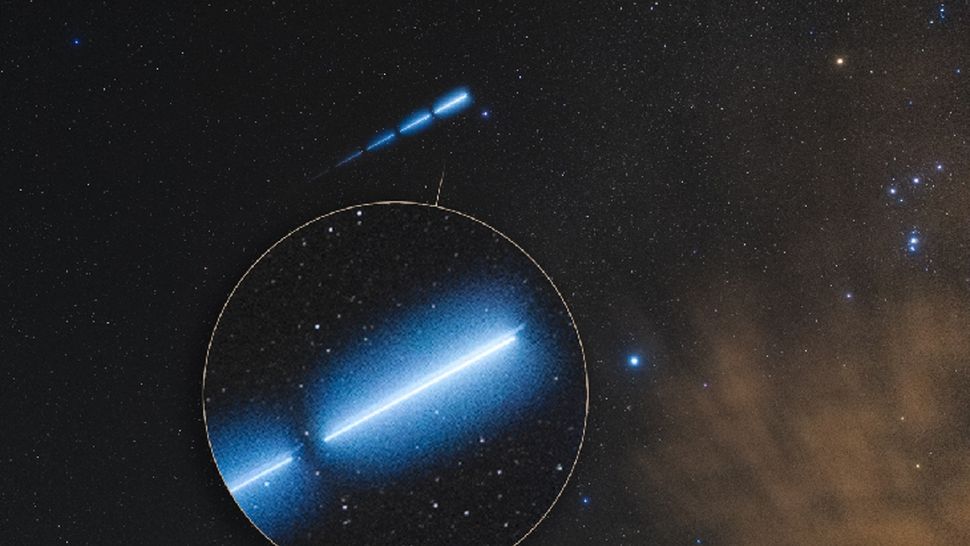
Dying SpaceX rocket creates eerie ‘dashed’ line in new photos. What’s going on? (Image Credit: Space.com)
Striking new photos show a perfect dashed line of light left behind by a dying SpaceX rocket in the night sky above Arizona. The luminous streak, which is the result of some clever photo trickery, is the latest reminder of the company’s rapidly increasing launch schedule.
On Saturday (March 30th), SpaceX launched two of their Falcon 9 rockets in less than four hours, Space.com reported. The first rocket, which was carrying the Eutelsat 36D telecommunications satellite, took off at 5:52 p.m. EDT from NASA’s Kennedy Space Center (KSC) in Florida. The second rocket, which was carrying 23 of the company’s Starlink satellites, launched from the Cape Canaveral Space Force Center, located next door to KSC, at 9:30 p.m. EDT.
After deploying their payloads, the rockets’ second stages — the main part of the rocket that separates from the rocket’s reusable boosters — underwent controlled deorbit burns, which caused them to fall toward Earth and burn up in the planet’s upper atmosphere.
Related: SpaceX moves Super Heavy booster to pad ahead of 4th Starship flight (photos)
Photographer Jeremy Perez had initially planned to capture the deorbit burn of the first rocket from near his home in Flagstaff, AZ but was left empty-handed due to thick cloud coverage. But by the time the second rocket began the same maneuver, the skies had cleared and Perez was able to catch some stunning images of the deorbiting debris, Spaceweather.com reported.
In the new images, Perez combined multiple long-exposure shots of the ignited second stage as it passed overhead. The breaks in the luminous streak represent points where the camera’s shutter was closed.

In real-time the event appeared very differently: “It looked like a delicate, cometary dandelion poof drifting overhead,” Perez told Spaceweather.com. The light also appeared white in real-time instead of the bright blues seen in the photos, he added.
In zoomed-in versions of the photos, you can also see a second dimmer line alongside the falling space junk. This streak is made up of light from the satellites deployed by the rocket, which were drifting alongside it before it started its final maneuver.
An increasingly common sight
Saturday’s twin launches were not the only SpaceX launches this week.
On Monday (April 1), another Falcon 9 lifted off from the Vandenburg Space Force base in California and later deployed 22 more Starlink satellites into orbit, Space.com reported. The company also plans to launch two more Falcon 9 rockets on Friday (April 5) and Sunday (April 7), which will both deploy more satellites into orbit, according to SpaceFlightNow.com.
The continued increase in SpaceX launches greatly enhances the chances of people seeing deorbiting material or other phenomena caused by the dying rockets, such as SpaceX spirals — swirls of light created by frozen rocket fuel ejected from deorbiting Falcon 9 boosters. For example, on March 4, one of these spirals briefly outshone the northern lights across large parts of the Arctic.

Falcon 9 rockets can also be seen for miles as they rise into space and can occasionally punch holes in the upper atmosphere, triggering blood-red aurora-like light shows.
But these light shows are not the only aspect of these ever-increasing launches that are catching people’s eyes. Experts are also concerned with the number of Starlink satellites that are being deployed into low-Earth orbit, which are obscuring our ability to study the cosmos.
When these newly-launched satellites inevitably fail and are sent to burn up in the upper atmosphere, they will also release high levels of metal pollution in our skies, which could have potentially damaging impacts.








